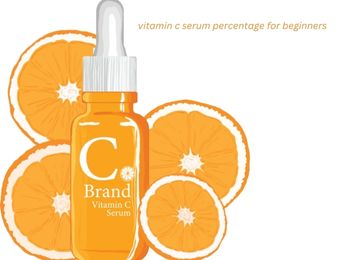Choosing the Right Vitamin C Serum Percentage for Beginners
- August 7, 2024
- Uncategorized
- 8 mins read
Choosing the Right Vitamin C Serum Percentage for Beginners
Vitamin C serums have become a staple in many skincare routines due to their potent antioxidant properties and ability to brighten the complexion. However, for beginners, selecting the appropriate vitamin C serum percentage can be daunting. This blog will guide you through the process of choosing the right vitamin c serum percentage for beginners, ensuring you achieve the best results without overwhelming your skin.
Understanding Vitamin C in Skincare
Vitamin C, also known as ascorbic acid, is a powerful antioxidant that protects the skin from environmental damage, boosts collagen production, and reduces the appearance of fine lines and hyperpigmentation. When incorporated into a serum, it becomes a concentrated treatment that can significantly enhance your skincare routine. For beginners, selecting the right vitamin c serum percentage for beginners is crucial to maximize these benefits while minimizing potential irritation.
The Importance of Vitamin C Serum Percentage
The effectiveness of a vitamin C serum largely depends on its concentration. Higher percentages of vitamin C can provide more dramatic results but may also irritate, especially for those with sensitive skin or those new to this ingredient. Therefore, understanding the right vitamin c serum percentage for beginners is crucial to avoid adverse reactions and ensure a smooth introduction to this powerful antioxidant.
What Percentage is Ideal for Beginners?
Starting Low: 5% to 10%
For those new to vitamin c serum percentage for beginners, it is advisable to start with a lower concentration, typically between 5% and 10%. This range provides antioxidant benefits and helps the skin acclimate to the ingredients without causing irritation or sensitivity.
Benefits of 5% to 10% Vitamin C Serum
- Gentle Introduction: Lower percentages are less likely to irritate, making them ideal for sensitive skin.
- Effective Antioxidant Protection: Even at lower concentrations, vitamin C can neutralize free radicals and prevent environmental damage.
- Gradual Improvement: Consistent use of a 5% to 10% serum can lead to noticeable improvements in skin texture and brightness over time.
Gradually Increasing: 10% to 15%
Once your skin has adapted to the lower concentration, you can consider increasing the vitamin c serum percentage for beginners to between 10% and 15%. This range offers enhanced benefits for beginners without significantly increasing the risk of irritation.
Benefits of 10% to 15% Vitamin C Serum
- Enhanced Brightening: Higher concentrations can more effectively reduce hyperpigmentation and even out skin tone.
- Boosted Collagen Production: Increased vitamin C levels stimulate collagen synthesis, promoting firmer, more youthful-looking skin.
- Stronger Antioxidant Defense: A higher percentage provides greater protection against environmental aggressors, such as UV rays and pollution.

Factors to Consider When Choosing a Vitamin C Serum
Skin Type
Your skin type plays a crucial role in determining the right vitamin c serum percentage for beginners. Those with sensitive or dry skin should start with a lower concentration, while individuals with oily or acne-prone skin may tolerate higher percentages better.
Product Formulation
The formulation of the serum also impacts its effectiveness and tolerance. For beginners, it’s essential to look for serums with a suitable vitamin c serum percentage for beginners, including stabilized forms of vitamin C such as sodium ascorbyl phosphate or magnesium ascorbyl phosphate, which are less likely to irritate.
Additional Ingredients
Many vitamin c serum percentages for beginners are formulated with additional beneficial ingredients, such as hyaluronic acid, vitamin E, and ferulic acid. For beginners, these added components can enhance the serum’s efficacy and provide additional hydration and antioxidant protection, making the right vitamin c serum percentage even more effective.
How to Incorporate Vitamin C Serum into Your Routine
Patch Testing
Before applying a new vitamin c serum percentage for beginners to your face, it’s essential to perform a patch test. Apply a small amount of the serum to a discreet area of skin, such as behind your ear or on your inner forearm, and wait 24 hours to check for any adverse reactions.
Gradual Introduction
When starting with a new vitamin C serum, introduce it gradually into your routine. Begin by applying it every other day and monitor your skin’s response. If no irritation occurs, you can increase the frequency of daily use.
Proper Application
For optimal results, apply your vitamin c serum percentage for beginners in the morning after cleansing and before moisturizing. This allows the serum to absorb fully and provides antioxidant protection throughout the day. Follow with a broad-spectrum sunscreen to protect your skin from UV damage, as vitamin C can make your skin more sensitive to the sun.
Tips for Maximizing the Benefits of Vitamin C Serum
Consistency is Key
To see the best results, consistency is crucial. Make vitamin C serum a regular part of your skincare routine and be patient, as it can take several weeks to notice significant improvements.
Store Properly
Vitamin C serums are sensitive to light and air, which can degrade their potency. Store your serum in a cool, dark place, and ensure the bottle is tightly sealed to maintain its efficacy.
Combine with Complementary Ingredients
Pairing your vitamin C serum with other antioxidants, such as vitamin E and ferulic acid, can enhance its effectiveness. Additionally, incorporating hydrating ingredients like hyaluronic acid can help prevent any potential dryness or irritation.
Common Mistakes to Avoid
Overuse
While vitamin C is beneficial, overuse can lead to irritation, especially for beginners. Stick to the recommended frequency and concentration to avoid overwhelming your skin.
Skipping Sunscreen
Vitamin C can increase your skin’s sensitivity to the sun, making it essential to use sunscreen daily. Skipping sunscreen can negate the benefits of your vitamin C serum and increase the risk of sun damage.
Ignoring Expiry Dates
Vitamin C serums can oxidize and lose their effectiveness over time. Pay attention to expiry dates and the color of your serum. If it turns dark or yellowish, it may be time to replace it.
Conclusion
Choosing the right vitamin c serum percentage for beginners is a crucial step in ensuring a positive experience and achieving the desired results. Starting with a lower concentration, such as 5% to 10%, allows your skin to acclimate to the ingredients without irritation. As your skin builds tolerance, you can gradually increase to higher percentages for enhanced benefits.
Remember to consider your skin type, the serum’s formulation, and any additional ingredients when selecting a product. Incorporate the serum gradually into your routine, and always follow with sunscreen to protect your skin. By following these guidelines, you’ll be well on your way to enjoying the brightening and anti-aging benefits of vitamin C serum.
Integrating a vitamin C serum into your skincare routine can provide remarkable results, but it’s important to approach it with patience and care. With the right percentage and proper application, beginners can safely enjoy the transformative effects of this powerhouse ingredient.
For beginners, starting with a vitamin C serum concentration between 5% and 10% is recommended. This lower percentage helps minimize the risk of irritation while allowing the skin to gradually adjust to the ingredients.
The suitability of a vitamin C serum depends on your skin type. If you have sensitive or dry skin, opt for a lower concentration (5% to 10%). For oily or acne-prone skin, you might be able to tolerate higher concentrations (10% to 15%). Always consider patch testing first.
Yes, if your skin has adjusted well to a lower concentration, you can gradually increase to a higher percentage, such as 10% to 15%. However, it’s essential to monitor your skin for any signs of irritation and adjust accordingly.
A 5% to 10% vitamin C serum provides antioxidant protection, helps brighten the complexion, and reduces signs of aging with minimal risk of irritation. It’s a gentle introduction for beginners to the benefits of vitamin C.
Apply the vitamin C serum in the morning after cleansing and before moisturizing. Follow with a broad-spectrum sunscreen to protect your skin from UV damage. Start with every other-day use to gauge how your skin reacts.
Yes, but it’s crucial to start with a lower concentration, such as 5%, and monitor your skin’s response. Look for serums formulated with stabilized vitamin C to minimize irritation and perform a patch test before full application.
For beginners, applying the serum every other day initially is recommended. As your skin builds tolerance, you can increase the frequency to daily use for optimal results.
Yes, vitamin C can be used alongside other beneficial ingredients like hyaluronic acid and vitamin E. However, avoid using it simultaneously with potent ingredients like retinoids or AHAs/BHAs to prevent potential irritation.
Store your vitamin C serum in a cool, dark place and ensure the bottle is tightly sealed. Vitamin C is sensitive to light and air, so proper storage helps maintain its potency and prevents oxidation.
If irritation occurs, reduce the frequency of use or switch to a lower concentration. Ensure you are applying the serum on clean, dry skin and avoid layering it with other potentially irritating products. If irritation persists, discontinue use and consult a dermatologist.



